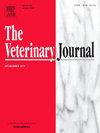Dried distillers’ grains with solubles as a key feed ingredient in dairy cow diets: Implications for colostrum quality and calf immunity
IF 3.1
2区 农林科学
Q1 VETERINARY SCIENCES
引用次数: 0
Abstract
The study evaluated the effect of incorporating dried distillers’ grains with solubles (DDGS) into the cow’s diet during the dry period on colostrum quality, concentrations of protein, and immunoglobulin G (IgG) in the serum of cows and calves. Three weeks prior to the expected calving date, cows were selected and assigned to four groups, each comprising 15 animals. The standard group (Group I) was fed a standard total mixed ration (TMR). Groups II, III, and IV received TMR supplemented with DDGS at rates of 1 kg, 2 kg, and 3 kg per head per day, respectively. Colostrum and blood samples were collected from all cows. Blood samples were also obtained from calves on the 3rd and 30th days of life. Analyses of colostrum: basic composition, amino acid profile, IgG, IgA, IgM, protein fraction distribution, and concentrations of Ca, P, Mg, K, and Na. In blood samples, total protein content and IgG levels were determined. Colostrum from cows in groups I and IV had decreased lactoferrin level compared to group II. In group III, an increase in IgG and total protein levels was observed. Regardless of the DDGS supplementation levels in maternal feed rations, an increase in total protein and IgG levels was noted in the serum of calves on both the 3rd and 30th days of age. These findings suggest that the use of DDGS in cow’s diets during the pre-calving period appears to enhance colostrum quality, and would seem to increase immunoglobulin levels and improve passive immunity in calves.
干酒糟及其可溶物作为奶牛饲粮的关键饲料成分:对初乳质量和小牛免疫力的影响。
本研究评价了在奶牛干期饲粮中添加干酒糟及其可溶物(DDGS)对奶牛和犊牛初乳品质、血清中蛋白质和免疫球蛋白G (IgG)浓度的影响。在预计产犊日期前3周,选取奶牛分为4组,每组15头。标准组(第一组)饲喂标准全混合日粮(TMR)。II组、III组和IV组分别以每头每天1kg、2kg和3kg的剂量在TMR的基础上添加DDGS。采集所有奶牛的初乳和血液样本。在犊牛出生后第3天和第30天采集血液样本。初乳分析:基本组成、氨基酸谱、IgG、IgA、IgM、蛋白质组分分布、Ca、P、Mg、K、Na浓度。在血液样本中,测定总蛋白含量和IgG水平。ⅰ组和ⅳ组牛初乳乳铁蛋白水平均低于ⅱ组。III组IgG和总蛋白水平升高。无论饲粮中DDGS添加水平如何,犊牛血清中总蛋白和IgG水平在3日龄和30日龄均显著升高。上述结果提示,产犊前期在奶牛日粮中添加DDGS似乎可以提高初乳质量,增加免疫球蛋白水平,改善小牛的被动免疫。
本文章由计算机程序翻译,如有差异,请以英文原文为准。
求助全文
约1分钟内获得全文
求助全文
来源期刊

Veterinary journal
农林科学-兽医学
CiteScore
4.10
自引率
4.50%
发文量
79
审稿时长
40 days
期刊介绍:
The Veterinary Journal (established 1875) publishes worldwide contributions on all aspects of veterinary science and its related subjects. It provides regular book reviews and a short communications section. The journal regularly commissions topical reviews and commentaries on features of major importance. Research areas include infectious diseases, applied biochemistry, parasitology, endocrinology, microbiology, immunology, pathology, pharmacology, physiology, molecular biology, immunogenetics, surgery, ophthalmology, dermatology and oncology.
 求助内容:
求助内容: 应助结果提醒方式:
应助结果提醒方式:


